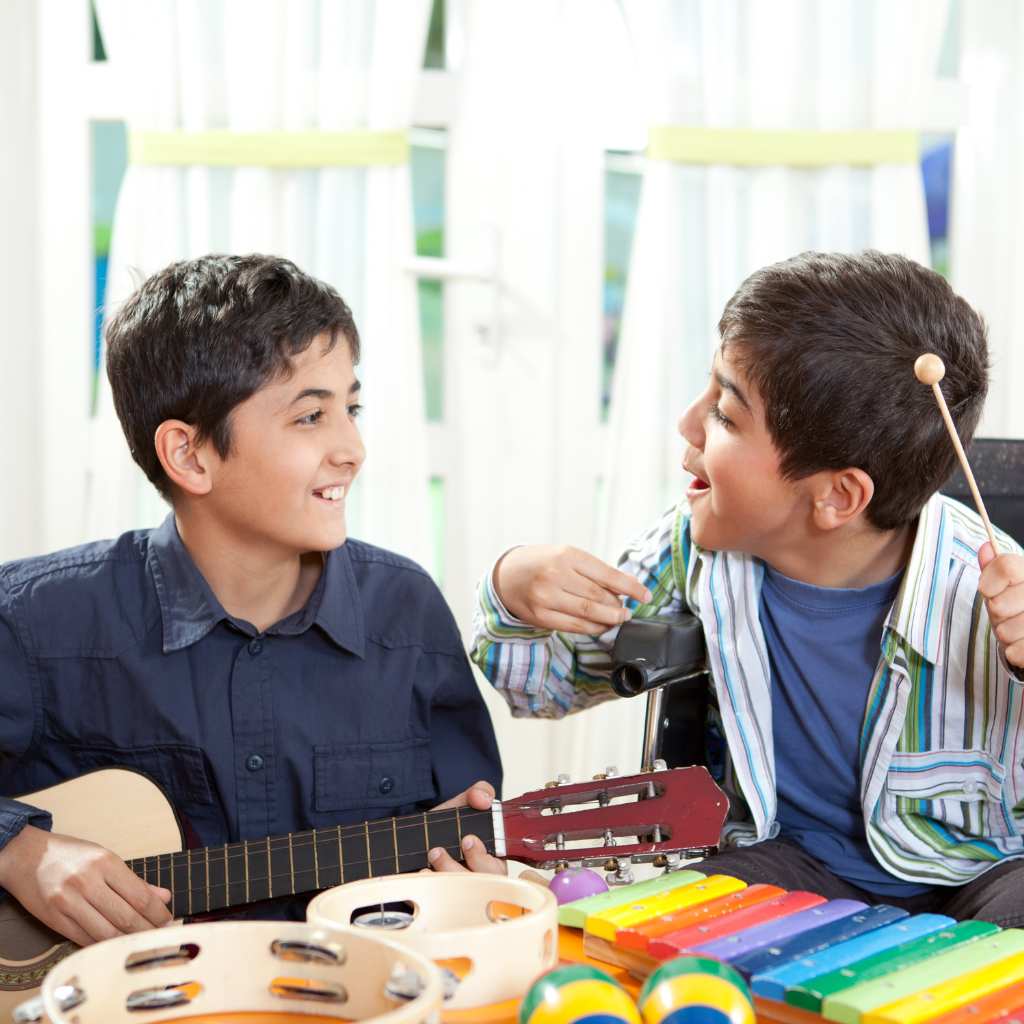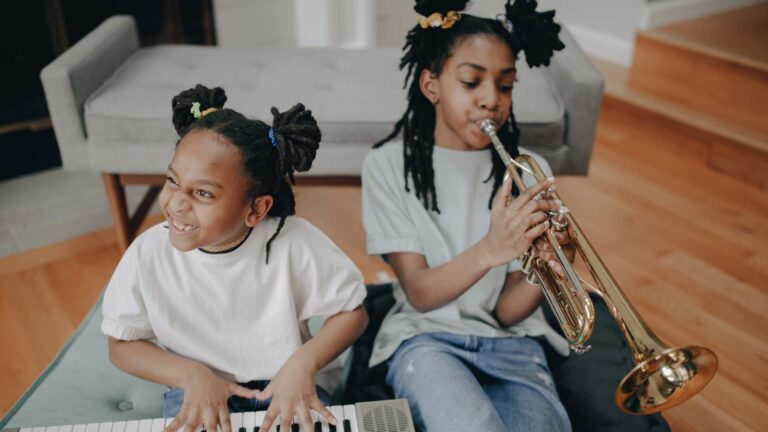Table of Contents
How does music therapy help autism?
Music is an art form that resonates with people of all ages and backgrounds. It offers a range of benefits, from enhancing concentration to connecting with our emotions. But did you know that music can also be therapeutic? Music therapy for autism is gaining attention for its holistic and creative approach to addressing various challenges in autistic individuals, including improving social and communication skills.
Now, you might be wondering: How does music therapy help autism? A study by the National Library of Medicine reviewed ten research papers with 165 children with autism spectrum disorder (ASD) to see if music therapy could help improve critical skills and interactions. It found that music therapy, over one week to seven months, was more effective than standard treatments for assisting children to engage in social interactions, communicate verbally and non-verbally, initiate interactions, and improve social-emotional responses. It also showed positive impacts on joy, social adaptation, and parent-child relationships, with no adverse effects.
Let’s explore this approach, its benefits, and how experts, parents, and caregivers in Doral, Miramar, Jensen Beach, Tampa, Orlando, Boca Raton, Melbourne, Davenport, and Kissimmee can apply it to address core challenges often faced by individuals with autism spectrum disorder (ASD) in this blog by ABA Centers of Florida.
Understanding Music Therapy

According to the American Music Therapy Association, music therapy is a clinical and evidence-based approach that uses music interventions to achieve specific goals within a therapeutic relationship, guided by a qualified professional trained in music therapy. This established healthcare practice addresses various areas, including behavioral issues, social interactions, mental health, communication skills, physical and motor functions, and cognitive abilities.
One of the unique strengths of music therapy is that it provides a non-threatening medium, allowing for meaningful and impactful outcomes. Sessions can incorporate a range of techniques and models, from behavioral and educational methods to those that support personal development.
How Music Therapy Sessions Work
Sessions might include:
- Active Music-Making: This can involve singing, playing instruments, or improvising music with guidance from the therapist. These activities support communication, social interaction, and fine motor skills. For instance, children may play a drum to express emotions or follow rhythm patterns to practice focus and coordination.
- Listening and Responding: Therapists might introduce specific songs or musical sounds and encourage the child to respond through movement or sound-making.
- Songwriting and Lyric Analysis: Older children and teens may work with a therapist to create original songs or analyze lyrics, providing a unique outlet for self-expression and a way to process feelings in a safe environment.
- Structured Play and Movement: Rhythm-based activities like clapping, dancing, or rhythmic movement engage both the mind and body. These activities can help with self-regulation, spatial awareness, and even social bonding when done in group settings.
Benefits of Music Therapy for Autism
Music therapy for autism is about much more than simply listening to music. When applied professionally, it uses music’s structured elements, like rhythm, melody, and repetition, to support the growth of communication, social engagement, and even emotional regulation.
Let’s get to know some of the benefits of music therapy for autism:
Enhanced Communication Skills – For many individuals with ASD, expressing thoughts and emotions through words alone can be challenging. Music therapy offers an alternative channel for communication, enabling children to express themselves through sounds, rhythms, or movements.
Social Connection and Engagement – Social interactions can be complex for individuals with autism, but music offers a non-verbal and engaging way to connect. In group settings, music therapy encourages cooperation, turn-taking, and eye contact. Activities like singing or playing instruments with others help individuals experience a sense of teamwork and shared purpose.
This safe, collaborative setting helps them become more comfortable with social interactions outside therapy.

The study The Effects of Structured Musical Activity Sessions on the Development of a Child with Autism Spectrum Disorder explored how structured music activities could help improve eye contact and communication skills in Hunter, a six-year-old with autism. Over several weeks, Hunter participated in 30-minute music sessions at home and in class, which included activities to boost social skills, verbal communication, and eye contact. The results were positive: his eye contact increased from 76% in the first session to 91% by the fifth, with noticeable improvements during discussions as well.
Observations and feedback from parents and teachers indicated that Hunter also showed greater social engagement, emotional expression, and musical skills, even improvising during a concert. He began using facial expressions, social cues, and verbal communication learned in sessions in his music classes, suggesting that the music activities supported his overall social development.
Emotional Expression and Regulation – Autism often brings heightened sensory sensitivities, which can make emotional expression and self-regulation complex. Music, with its predictable structure and emotional resonance, offers a soothing, familiar outlet for managing intense feelings. Music therapists use specific tones, rhythms, or tempos that match the individual’s emotional state, then gradually adjust them to guide the person toward calm or focus.
Improved Motor Skills and Coordination – Playing instruments and moving to music can improve fine and gross motor skills in children with autism. Activities that involve clapping, drumming, or dancing provide a structured, enjoyable way to practice motor control, balance, and hand-eye coordination. These improvements in physical abilities often carry over into everyday tasks.
How Do Children with Autism Process Music?
According to the International Journal of Environmental Research and Public Health, Children on the spectrum may use music to address cognitive, emotional, and social needs, such as managing mood and fostering social connections. They tend to prefer music over spoken words, showing superior pitch memory and a greater enjoyment of dissonant sounds. Physiologically, children with autism respond more strongly to preferred music than their neurotypical peers and often gravitate toward predictable, upbeat music, which activates brain areas linked to happiness.
For some, music serves as an anchor, providing rhythm and predictability that can feel reassuring. For others, music’s emotional cues—such as the upbeat feeling of a fast tempo or the calmness of a soft melody—are more accessible to interpret than spoken words.
4 Ways to Incorporate Music in Your Kid’s Life
While music therapy sessions provide structured support, parents can also incorporate musical activities at home to reinforce these benefits. Here are some ways to bring the therapeutic power of music into daily routines:
1. Create a Music-Listening Routine
Find calming or upbeat playlists for specific times of the day. For example, soothing music in the evening can help with winding down, while rhythmic, energizing songs can make morning routines more enjoyable. Tailoring music choices to suit your child’s energy level or mood can create a comforting routine.
2. Engage in Musical Play
Introduce instruments, whether simple ones like tambourines or more complex ones like keyboards and let your child explore them. Musical play helps develop sensory tolerance, coordination, and expression. Letting children experiment with sounds in a low-pressure environment can foster creativity and enjoyment without overwhelming them.
3. Sing Songs Together
Singing familiar songs together not only encourages language development but also builds social connections. Try making eye contact while singing or incorporate gestures to support engagement and interactive learning.
4. Dance to the Beat

Moving to music is a fantastic way to help children develop body awareness and coordination. Dancing also gives children a healthy way to release energy and emotions, making it a fun tool for self-expression.
ABA Centers of Florida Helps Enhance Essential Life Skills
At ABA Centers of Florida, we know that developing essential life skills is vital for children on the autism spectrum, and therapies like music therapy and applied behavior analysis (ABA) can offer children valuable support in achieving these milestones. While ABA therapy remains a cornerstone of autism support by helping build communication, social, and self-management skills, we recognize that complementary therapies, such as music therapy, can bring additional, profound benefits.
Our goal is to provide a comprehensive approach that empowers individuals with autism and supports families every step of the way. If you’re curious about how ABA therapy can support your child’s growth, our team is here to help. Call us at (772) 773-1975 or schedule a free consultation with our autism experts here.








